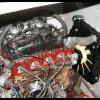I'm having problems with my Smiths gauge,
Before it used to register the volts correctly, when testing with a 9v battery the needle used to come to a rest just before the 11 now however it rests on the 11. When connected to a 12v battery the needle swings all the way to 15 if not a little above.
Any ideas?
Thanks
Edited by GreaseMonkey, 16 February 2009 - 08:47 PM.

















